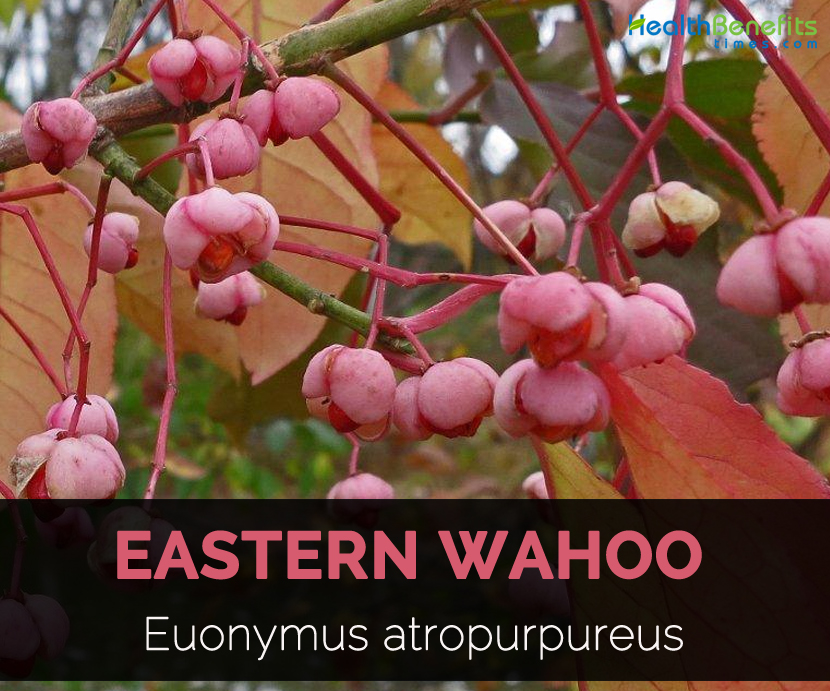| Eastern wahoo Quick Facts | |
|---|---|
| Name: | Eastern wahoo |
| Scientific Name: | Euonymus atropurpureus |
| Origin | Native to eastern North America |
| Colors | Reddish to pink |
| Shapes | Capsule, up to 17 mm diameter |
| Name | Eastern wahoo |
|---|---|
| Scientific Name | Euonymus atropurpureus |
| Native | Native to eastern North America |
| Common/English Name | American wahoo, Burningbush, Eastern wahoo, Hearts bursting with love, Bitter ash, Indian arrow, Euonymus, Indian arrow wood, Pegwood, Strawberry tree, Spindle tree, Whahow, Wauhoo |
| Name in Other Languages | German: Purpur-Spindelstrauch, Bitter-ash, Burningbush, Eastern burningbush, Eastern wahoo, Wahoo, Eastern burning-bush, Burning-bush euonymus; French: Fusain pourpre, Fusain de l’Est |
| Plant Growth Habit | Deciduous shrub |
| Soil | Well-drained |
| Plant Size | 8 m tall |
| Bark | Gray, smooth and lightly fissured |
| Stem | Round, smooth, 10 cm diameter |
| Leaves | Elliptical, 8.5–11.3 cm long, 3.2–5.5 cm broad |
| Flowering Season | June |
| Flower | Bisexual, 10–12 mm diameter |
| Fruit shape & size | Capsule, up to 17 mm diameter |
| Fruit color | Reddish to pink |
| Seed | Orange, ellipsoid, 7.0 to 11.0 by 4.0 to 5.5 mm |
| Medicinal part | Root bark |
Leaves and stems
Leaves are opposite and simple about 2 to 6 inches long, 1 to 2½ inches wide which are generally elliptic, widest at or near the middle tapering or wedge shaped at the base. Tip is pointed or tapering to a sharp point sometimes abruptly so finely toothed around the edges and hairless on the upper surface and finely hairy on the lower. Stalks are ¼ to 2/3 inch long and hairless. Leaves turn yellow in the fall. Branchlets are weakly four sided, hairless, green and develops lines of pale and corky tissue along the angles which provides a striped appearance but eventually fade away. Branches are brown with age. Buds are cone shaped with sharply pointed tip. Bud scars are very light and nearly white. Older bark is thin, smooth to slightly rough and gray to gray brown. Trunks reach 1½ inches diameter at breast height. Usually stems are single and branches are few and erect to ascending, the shrub taking on an irregularly shaped crown.
Fruit
Fruit is a capsule about ½ inches across. Initially it is green turning pinkish and maturing to red. Typically four lobed but not all lobes may develop equally. When ripe, capsule splits open revealing 1 to 4 fleshy and bright red fruits called arils which contain two seeds.
Distribution and habitat
It is primarily found in the Midwestern United States. The range extends from southern Ontario south to northern Florida and Texas. It is found in low meadows, open slopes, open woodland, stream banks and prairies, in moist soils especially thickets, valleys and forest edges.
Uses
Valued in liver disorders especially those following or accompanied by fever. For constipation due to inactivity of liver it may be given with every confidence, especially as its action is mild and non-irritant. The influence is not restricted to the liver alone, the pancreas and spleen are also assisted by its properties. An effective agent for dropsy and dyspepsia, having cathartic effect. Euonymus is often used in combinations of other tonics, laxatives, etc., in pill form.
Doses
1 small teaspoonful to 2 cupfuls of boiling water, simmered 30 min., 2–3 cupfuls a day 1 hr. before meals.
Medicinal uses
- It has expectorant and diuretic effects but is used as purgative in case of constipation.
- It is used for liver disorders and fever.
- Prepare a decoction by adding an ounce to a pint of water and boil it slowly. Take a dose of small wineglassful two to three times a day for cold.
- Stem and root bark is used as a cardiac, alterative, cholagogue, cathartic, expectorant, diuretic, laxative, hepatic, tonic and stimulant.
- Use it in form of tea for treating malaria, constipation and liver congestion.
- Apply the powdered bark to the scalp for eliminating dandruff.
Side effects
- Pregnant and breastfeeding women should not take it.
- Bark of Eastern wahoo has caffeine so when taken in large amounts, it worsens diarrhea and IBs.
- When taken in large doses, it causes intestinal and stomach disorders.
References:
https://www.itis.gov/servlet/SingleRpt/SingleRpt?search_topic=TSN&search_value=27948#null
https://www.missouribotanicalgarden.org/PlantFinder/PlantFinderDetails.aspx?kempercode=k240
https://botanical.com/botanical/mgmh/s/spindl82.html
https://en.wikipedia.org/wiki/Euonymus_atropurpureus
https://pfaf.org/user/Plant.aspx?LatinName=Euonymus+atropurpureus
https://www.planetayurveda.com/wahoo-bark/
https://www.minnesotawildflowers.info/shrub/eastern-wahoo
http://medicinalherbinfo.org/000Herbs2016/1herbs/wahoo/


